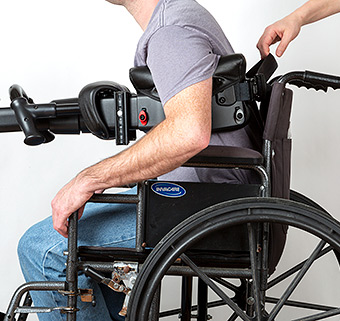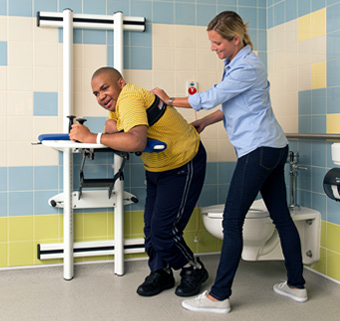Out in Front with Mechanical Lifts in Schools
Four Districts that are Pioneers
| February 2017Last week I attended the Combined Section Meeting of the American Physical Therapy Association. It was held in San Antonio (great choice, especially in February!) and included some excellent programming. I’d like to share highlights from one of the workshops which focused on using lift and transfer devices in schools. It was presented by therapists from four large school districts.
 Each district acknowledged the research clearly showing how unhealthy manual lifting practices result in injuries, lost days from work, increase in workers’ compensation claims and high staff turnover rates. One study in particular was the Campo 2008 survey of APTA members on the experience of work-related injuries. Of those interviewed, school-based therapists had the highest rate of injury – most likely due to the frequency of toileting and gait training transfers done on a daily basis. Then each district recognized the evidence showing how these appalling injury rates can be reduced by good lift policies and the use of mechanical lifts. Although eleven states now have minimal lifting policies established in healthcare facilities, nothing has been done for schools yet. We took a survey at the beginning of the course and discovered that approximately 9% of course attendees had lifting programs in their schools, about 60% didn’t, and 35% “sort of” had some guidelines. So these four districts are pioneers and have remarkable success stories to tell.
Each district acknowledged the research clearly showing how unhealthy manual lifting practices result in injuries, lost days from work, increase in workers’ compensation claims and high staff turnover rates. One study in particular was the Campo 2008 survey of APTA members on the experience of work-related injuries. Of those interviewed, school-based therapists had the highest rate of injury – most likely due to the frequency of toileting and gait training transfers done on a daily basis. Then each district recognized the evidence showing how these appalling injury rates can be reduced by good lift policies and the use of mechanical lifts. Although eleven states now have minimal lifting policies established in healthcare facilities, nothing has been done for schools yet. We took a survey at the beginning of the course and discovered that approximately 9% of course attendees had lifting programs in their schools, about 60% didn’t, and 35% “sort of” had some guidelines. So these four districts are pioneers and have remarkable success stories to tell.
1. Fairfax County Public Schools, Virginia, presented by Adrianne Moffitt, MSPT, PCS
Fairfax conducted a survey in 2009 to determine training needs, use of lifting equipment and barriers to its use. They discovered that many of their staff felt uncomfortable using safe lifting equipment. For some it was the extra time it took to use get the equipment. For others, the equipment they needed simply wasn’t available. And still others did not understand its benefits.
Today this district has safe lifting guidelines based on NIOSH’s 35lb weigh-limit recommendation, a centrally located therapy service department that provides all equipment, a collaborative initiative to have safe and effective personal care spaces in all buildings and incentives to attend lifting trainings.
2. Baltimore County Public Schools, Maryland, presented by Karen Greeley, DScPT
The Maryland State Steering Committee for OT and PT School-based Programs was the driving force behind the changes seen at this district. This forum of school-based therapists and other stakeholders created a Lifting and Transferring Guideline, an algorithm based on current evidence and best practices, which is now included in the Academy of Pediatric Physical Therapy fact sheet on safe student lifting and transfers. They also developed a Guide to Practice for Administrators and OT and PTs which is being used now in schools throughout the state of Maryland.
3. Dorchester School District II, South Carolina, presented by Lori Bartelson, PT, DPT
This district began its safe lifting journey when a teacher was injured by lifting students with severe involvement in a high school class. (She had received lifting training, but was not using safe patient handling.) As a result she had long term disability and couldn’t return to work. The class was without a teacher and the  school could not fill the position easily. The district wanted to avoid this happening again, so they began school and PT consultations.
school could not fill the position easily. The district wanted to avoid this happening again, so they began school and PT consultations.
For their targeted programs and classrooms they installed overhead track lifts and for targeted students they used a Hoyer® lift and Rifton TRAM. With the equipment in place, the goal now is to educate staff, assure student participation in transfers even with the lift equipment and put state and district lifting guidelines in place.
4. High Desert Education Service District, Oregon, Material contributed by Jill Barrett, PT
Because of the unusually high rate of work-related injuries among the special education staff in this district, concerned therapists partnering with the administration implemented a safe patient handling policy indicating the use of transfer equipment if a child is over 30 lbs or with any student who could not safely and reliably stand and pivot. Training employees about the program, performing environmental assessments and prioritizing high risk classes additionally dramatically reduced staff injuries.
In the final part of the presentation we discussed the practical applications of using a lift in schools while considering these questions: who, when, why, what, where.
Who? Consider using a lift for any student in the school system compromising staff or student safety. This could include even young children such as a student with spastic quadriplegic cerebral palsy or a preschool child with global developmental delay weighing 70 lbs. To more effectively tackle lifts and transfers and assure adequate training, the presenters recommended forming lift teams—staff that are specifically trained to use the mechanical lifts.
When? Consider using a lift to improve efficiency and access to the environment, improving student independence and positioning, and when a child requires multiple toileting transfers during the day.
Why? Using lifts is essential to ensure both student and staff safety, improve the dignity of a student and allow full access to the school’s environment.
Where? Mechanical lifts have been successfully used in both self-contained and general education classrooms, on field trips, in physical education, for toileting and at home. Having a lift plan for emergency evacuation is important as well.
What? As there are many lifts out there, the presenters gave great tips about the ones especially designed for the school-based environment and what they find most useful (or unattractive) about them:
Hoyer® Lift:
- Use for children who also use it in their homes and come to class with the sling under them
- Slings are challenging
- Older models don’t provide maintenance
Rifton TRAM: A transfer and mobility device offering sit-to-sit and sit-to-stand transitions as well as gait training support
- This is a “go-to” lift and solves many school transfer problems
- Great opportunities for student participation
- Option for student to operate device
- Used for toileting transfers and gait training
- Small footprint allows students to toilet in classroom bathroom
Easy Pivot
- Works well for hygiene care
- Good option for children with Duchennes muscular dystrophy
Track Systems
- Gives a child access to entire classrooms [I thought this was a drawback of a track system, that it only allowed the child to travel under the track], but often not feasible to implement widely
The presenters reminded us to incorporate mechanical lifts into IEP goals to show their use, effectiveness and value. Here’s an example they gave: To improve independence at school, Mary will stand up from her chair and maintain standing using the mechanical lift for physical support to transfer, and adult supervision and support to operate the mechanical lift, twice daily on 3 out of 4 opportunities measured quarterly.




